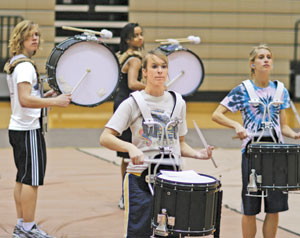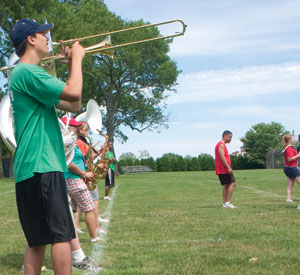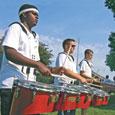Seven Directors Share Their Thoughts on the Upcoming Season

The Full Effect
David Starnes
Kennesaw Mountain High School, Georgia
We’re using a specialist just for visual effects this year. Visual is changing; the current trend is to use more body and foot movement, so we’re going to have wind players learn some dance moves. The show has more of a staged approach rather than just drill. Last year’s show had 145 sets of drill in it, and we’re trying to do less on-the-move playing and more choreography. We do posture breakdowns within our basics block and cover some basic ballet positions and tendu exercises, separating the upper and lower body in stretch exercises.
Musically, we are using more electronic instruments in the front ensemble. We started using a Mallet Kat last year to get harp and guitar sounds, and this year we’ve added Drum Kats, three synthesizers, and MIDI wind instruments to create some different sonorities. This year we are considering an oboe/bassoon duet. Using MIDI winds makes it possible to get those sounds on the field without bringing these instruments outside. In addition, one of our pieces has some choral music in it, so we’re going to split soprano, alto, tenor, and bass up between the MIDI winds to create a choir by sampling each of those voices.
We run everything through a digital 32-channel mixer, with numerous speakers placed in the front ensemble. Two are used as monitors, and there are four output speakers with two additional sub-mixers for bass resonances. Last year we miked all the acoustic keyboard percussion, so this year we’ll add one more layer to that with the electronic instruments. We run everything off a generator so we know we have power. We actually browned out a stadium one night because of how much power we ran through one outlet.
Our program this year takes advantage of the colors on our uniforms. Our uniforms have a dark back from the bottom of the pants up to the collar, and the front is a dove gray with some gradations of darker green. By turning the entire band backwards we have a black curtain, and then we can have people turn to face front in any number of combinations, such as by section or by sound color. It makes it possible to showcase many different sound combinations.
To work on making this effective, we will teach point and 180-degree turns that extend one leg or the other depending on direction but also amplifying the upper body and arms. Some of that stems from the ballet and tendu styles of movement that are increasingly prevalent. A couple of staff members are experienced in body and dance, so they will train the wind players from day one in a warm-up block that we will run music to. We’ll go through these different exercises and dance steps daily as part of the warm-up and will just adapt that vocabulary straight to the movement in the show.
One unusual aspect of our program is that we don’t march trombones. I prefer an extremely dark, warm low brass sound, and to get that we march baritones. Typically we field 20-24 baritones, and our arrangements have three separate baritone parts.
It’s not difficult to teach trombonists to double. In spring we start with next year’s freshmen. We teach three to four notes and create exercises based on these. Throughout the summer, before camp starts, they meet with section leaders and work further. We’ve actually grown some great trombone players who can double on valved instruments in symphonic bands. In Georgia you can play in two different ensembles at a district or GMEA festival, but the second instrument has to have different fingerings. This permits students to play trombone in an advanced ensemble and then play a valved instrument to help in a less-experienced group. In 10 years I’ve never had a student tell me that they didn’t like it. They push back at first, but once they figure it out, their trombone playing improves tremendously, simply because the bore size of a baritone is so much bigger. They go back to trombone in concert band and sound much more resonant.
Manual of Style
John Panella
Rochester Area High School, Pennsylvania
We are adding a second band handbook this year. In talking with other directors, I have found a number of schools have a defined style that is written out in a manual. This typically spells out the style and how movements should be performed, along with pictures that show exactly how the correct form and posture look. We are going to define a style that’s unique to our band and try to perfect it. We’re going to teach marching fundamentals differently, trying to be much more specific, especially with defining a style. The goal is complete uniformity. The style book includes marching basics and transitions, such as moving from parade rest to attention, as well as some of the unique things that make our band stand out.
My visual coordinator is writing the manual. I’ve given her my thoughts, and she knows what we do, so she’s putting it together right now. I’ll look at her version and edit, but she’s doing most of it.
We have to start over, so all the veteran members are going to have to be patient and take what they’ve learned over the last few years, and while a lot of it will be the same, we’ll be paying much more attention to detail. I have a strong senior class this year and that’s going to make it much easier. During summer re-hearsals and band camp we will devote a lot of time to marching basics, probably an hour and a half to two hours every day.
I have a fairly big staff for a band our size, but I usually have them all together during band camp and at performances. They’re not always all there at evening rehearsals during the school year; at some practices it’s just me. So I really rely on student leaders. I have a drum major, an assistant drum major, captains for brass, woodwinds, drumline, pit, two colorguard captains, each of which has a specific, written-out job description. They take over the role of a quasi-instructor when the instructors aren’t there, although student leaders have to understand they are not staff but still students, and there are authority lines they are not allowed to cross.
One of the most interesting ideas I’ve seen is a circle drill. All the wind players stand facing each other in a circle, which can expand or contract by having students march forward or backward. The circle is also a good way to work on left and right slides. It forces students to look at each other and keep spacing, and it works especially well as a quick marching warm-up for an unlined field, because the goal is to keep the circle rather than all hit a marker at the same time.

Carefully Crafted Exercises
Brandon Barrometti
Centerville High School, Ohio
It can be a struggle to balance work on playing and marching fundamentals with learning the show; in the heat of the season, fundamentals are always the first to go. Our plan for fall is to emphasize fundamentals a bit more. We’re big on keeping the music and the visual very closely related. The way to improve in both areas is to go back to things you’re capable of doing in an isolated situation and then putting it in the context of the show.
Our work each year starts with producing a good sound and continues with such basics as interval exercises or articulation exercises to the music. We relate everything back to concert F and do interval exercises based on that. One exercise we do is have half the band play interval exercises going up while the other half plays interval exercises go-ing down, so students can hear the relationships. It’s a way to get students to listen to things they may not be used to hearing. The key is relating the fundamentals to the music, but also relating the music back to the fundamentals.
We also want to emphasize marching technique and style more and perfect these skills outside of the drill, so that when students do it in the drill it seems a lot easier. We like to have students do box or diamond exercises with multiple direction changes. We increase the tempo or change the step size to keep it closely related to what they do in the show. We get students comfortable doing isolated difficult moves and then make the focus of rehearsal a part of the show that has those same kind of moves.
We have a week of mini-camp in late June to teach a lot of the fundamentals so that when we get to band camp we can spend some time getting into the show a little bit. We try to teach skills they’ll need to know for the drill before they even have drill in their hands.
Drum corps do quite a bit of physical conditioning, so we also do physical conditioning in the June mini-camp but try to make it fun. We rehearse from 9-5, but after 5 we’ll hang out in the gym and play dodge ball or basketball – just different activities for students.
We also line everybody up on the goal line and have everybody run one length of the field, do 20 jumping jacks, and then run back and do a different exercise. Later in the fall we run with a metro-nome to force students to keep their feet in time while they run. It trains them to get used to keeping their bodies in time as well. We’ll start at 100 beats per minute, which is a comfortable jogging tempo, but then when students get good at that we turn it up 10 clicks per week. At 140-150 beats per minute students are in a full run.
In August band camp students start with basics in the morning, and once their memories have been refreshed they get into learning more things instead of reviewing basics. My favorite part of band camp is seeing how students change over the course of a week. It’s amazing what they’re able to do by the end of that week. We give a performance for parents on the last day to show what they’ve learned. It’s great to be able to show off what students have achieved after just a week together.
One Step at a Time
Ben Burge
Northwest Rankin High School, Mississippi

This year we are marching in the Chicago Thanksgiving parade, so we will concentrate on block band fundamentals. Typically we do block band fundamentals, but we usually teach a concept, run it a few times, and then let students break into sectionals to work on it. This year we’ll spend a lot more time in the full-band fundamentals block. Specific things to practice in block band are step size and turns, both of which are relevant to our trip in the fall but also an important part of marching fundamentals. We’ll try to do parade-specific things at the beginning of each rehearsal before we start drill.
Everything is sequential, and we add one technique at a time. We teach parade rest first, then we teach the command to move from that to attention. When we have attention down we move to mark time. Then we add them all together before moving to forward march, which is when we introduce the step size. From step size we go to moving forward, then the halt. If you teach these things sequentially, they make more sense, and students understand that they always have to come back to these points.
To work on step size, we take the first step and pull the toe back. When the first step is consistent, add the second foot, then pull it back to the line. Then we do it again at a different tempo. The goal is to get students used to what that first step feels like. Then we add steps and vary the tempo more, and by the time students hit the next yard line they have a good feeling of how big the step size is. We work on alignment using peripheral vision.
A Strong Identity
Randy Greenwell
Lawrence Central High School, Indiana
Judges want to see clear ideas and clear identities. The best thing any band can do is be true to its identity. Within that identity you can stretch yourself into different genres, but it’s the music that changes, not the ap-proach. I remember talking with a director who commented that some years he didn’t march any clarinets; he marched all saxophones. It made sense when he explained why, but it wouldn’t work for my group.
Rather than try to imitate the sound of another band, it is better to make adjustments to produce the band sound you want. What we do probably wouldn’t work for anyone else. The goal is not to sound like someone else, but to find how much we can grow within our identity.
The main thing is to formulate a plan and stick with it. Don’t blow off basics. Find the students who grasp your style well and use them as models so the others can see what it looks like when done right. Our goal is to have section leaders who can demonstrate those skills at a high level so that students know it is possible to excel at marching. Every four to five years it seems some teaching technique stops working, and we gravitate toward another method.
People ask why our students have a carriage about them, and a lot of it stems from that concept of center of balance. It is important that our students be able to work both on and off center of balance, and to get there, students have to be trained in the elements of fundamental dance. During a two-week camp in June we work on basic dance training, and students learn a warm-up that we will use throughout the year. This warm-up uses many of the skills necessary to learn the choreography for the show. We pick and choose from techniques from modern dance and ballet – things we might need to learn based on what our visual coordinator suggests might fit the music well.
The show dictates the changes we make to our basics program. In the last couple years we’ve ventured into moving forms while dancing. In basics block students learned how to take a basic form and move it left or right, maintaining intervals and spacing, so when we did it in the show, they’d already been doing it for 50 some days.
A Head Start
Jay Webb
Avon High School, Indiana
Last year we were still learning our closer in the middle of the season. This has been typical for us lately, but it’s not ideal. We’re trying to get an earlier jump on the show. We want to avoid having students clean and perfect one part of the drill while they’re still learning another part.
We have a pretty intensive June, with two or three three-hour evening rehearsals for four weeks. After three weeks off, students have two weeks of band camp. We go to a university for a week and hold the other week of camp at school. Between band camp and the start of school we have a few rehearsals.
In June percussion, winds, and colorguard are usually separate; the band hardly ever practices together in June. We spend 90% of the early season on fundamentals. On the back half of the season that number falls to about 25%, but we never stop working on the basics. We really focus on breathing and producing a great sound and taking a great first step and having great posture. Everything falls into place once these fundamentals are well established. At band camp we will start pulling the show together.
Something for Everyone
Andy Sigman
Waterford High School, Ohio
This year’s show theme has a bit of something for everybody, so hopefully it will be more entertaining for all our crowds. We’re going to chart some more complex drill moves – different formations and effects with feet and upper body.
We teach these techniques by showing them to the entire group, then everyone breaks into sections with section leaders and band camp staff teaching each group. Next we put it back together. Whenever you have the chance to put a visual in, whether it’s with music or with percussion or both, try to keep adding more in. The show is never finished until the end of the year, so always have something new and exciting for the adjudicators and the crowd to see.






